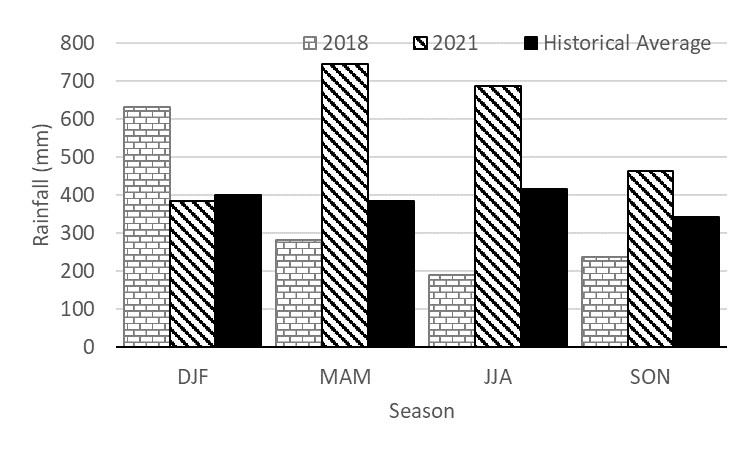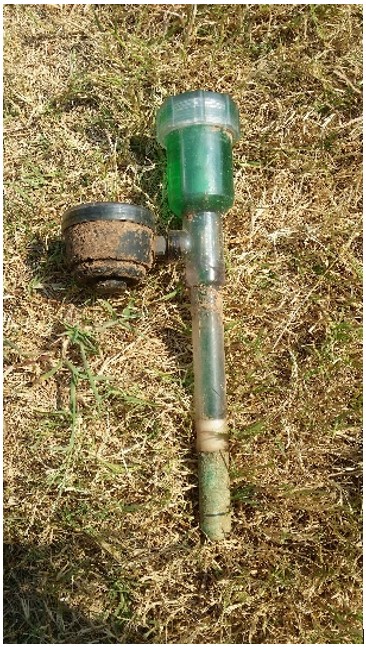By Stacia L. Davis Conger, Ph.D., State Irrigation Specialist, LSU AgCenter
Inherent to the southeastern United States, rainfall in hot-humid climates is highly variable in both frequency and duration. In Louisiana, historical rainfall averages 1,350 – 1,700 mm (53 – 67 inches) annually with most dry periods expected during the summer months (Sohoulande et al., 2021). However, historical patterns may not fit actual conditions in any given year (Figure 1). This unpredictability can impact the growth and quality of small fruits due to either abundant or elusive availability of soil water during critical portions of the crop season. For example, blueberries generally require water during berry swell, fruit set, and through harvest (Lamont, Jr. et al., 2001), which typically occurs throughout May and June, depending on variety (Cambre and Sharpe, 2018). Complicating this issue, high quality freshwater resources typically used for agricultural irrigation have become increasingly difficult to access economically. Thus, we must work toward monitoring the soil water status during critical growth stages and only apply irrigation when necessary.

Over the years, the irrigation industry has embraced technological advancements including products that aid in making irrigation decisions. Soil moisture sensors are one such technology that can provide real time feedback on soil water status in the root zone. Further, sensor data can act as the irrigator’s eyes below the soil surface and provide insight into root growth, soil structural conditions, and overall plant health. This data is especially advantageous when physiological damage can occur before visual cues of water stress emerge in the aboveground plant material. Water stress can lead to various consequences including reductions in vegetative growth, flowering, fruit size, yield, and quality of yield (El-Farhan and Pritts, 1997). Sensors can estimate soil moisture differently, but most research has utilized soil water potential (SWP) sensors in production systems for small fruits.
The SWP represents the energy that must be exerted by the plant to overcome the forces that hold the water in the soil profile and is measured in units of pressure (e.g., kPa, cb). Though not a sensor, the original product used to measure SWP for irrigation is the tensiometer (Figure 2). These devices consist of a water-filled tube under vacuum, clay porous tip buried to the appropriate root zone depth, and a pressure gage maintained above the soil surface. As the soil dries over time, water is pulled from the tube through the clay tip resulting in an increase in negative pressure. The critical water levels for irrigation are saturation, field capacity, and permanent wilting point, which measure 0 kPa, -10 kPa, and -1,500 kPa, respectively. However, the irrigation threshold is specific to the plant material and dependent on criticality. In California, optimal irrigation occurred at an irrigation threshold of −10 kPa in open-field strawberry production systems (Gendron et al., 2018). Similarly, maximum yield was obtained at a threshold of -10 kPa, but fruits per plant and fresh weight per fruit were reduced when irrigating at thresholds of -30 kPa, -50 kPa, and -70 kPa in Spain (Serrano et al., 1992). Comparatively, blueberries can tolerate longer drought periods than strawberries, but should be irrigated well before reaching the critical water potential, which is achieved at full stomatal closure and varies based on variety (Davies and Johnson, 1982). The sensor version of the tensiometer is called a granular matrix sensor, soil water potential sensor, or soil matric potential sensor depending on the manufacturer; sensors are advantageous to tensiometers due to reduced maintenance needs during the growing season and automatic sub-daily data collection that reduces the burden of frequent manual data collection during critical growth stages.

Proper placement within the field and within the bed are critical to collecting good information for making irrigation decisions. All sensors should be installed in a representative portion of the field, away from edge effects, and easily accessible for recording or downloading data. Loggers equipped with telecommunication capability should be considered in situations where access during the growing season may be difficult. At least one sensor should be placed near the root ball of the plant, where most of the water is accessed, when irrigation decisions are the only purpose. If tracking water movement within the soil, multiple sensors can be installed at different depths and portions of the plant bed for a more dynamic perspective. For example, adding an additional sensor below the root ball can indicate when to cease an irrigation application to minimize overwatering. If soils have high sand content, a volumetric water content (VWC) sensor may be more appropriate, but can increase the complexity, applicability, and cost.
Irrigation decisions made using soil moisture sensors can result in higher yields, better quality fruit, and lowered production costs due to more informed water management practices. In some cases, the investment costs associated with purchasing sensors are returned within one season due to yield representing the largest driver of cost effectiveness (Gendron et al., 2018). Although many studies have been conducted on irrigation water requirements of various small fruits, there are still many varietal and environmental factors affecting irrigation strategies that should be explored. Additionally, future research should focus on addressing possible adoption barriers such as gaining confidence in trying new technologies, building trust in the sensor data, and developing strategies for adjusting management styles.
References
Cambre, K., and K. W. Sharpe. 2018. Blueberries. LSU AgCenter News Article. Available at: https://www.lsuagcenter.com/articles/page1528813108744. Accessed on 21 June 2022.
Davies, F. S., C. R. Johnson. 1982. Water stress, growth, and critical water potentials of Rabbiteye Blueberry (Vaccinium ashei Reade), J. Amer. Soc. Hort. Sci. 107(1): 6-8.
El-Farhan, A. H. and M. P. Pritts. 1997. Water requirements and water stress in strawberry. Adv. in Strawberry Res., 16:5-12.
Gendron, L., G. Létourneau, L. Anderson, G. Sauvageau, C. Depardieu, E. Paddock, A. van den Hout, R. Levallois, O. Daugovish, S. S. Solis, J. Caron. 2018. Real-time irrigation: Cost-effectiveness and benefits for water use and productivity of strawberries, Scientia Horticulturae, 204, 20 October 2018, 468-477, https://doi.org/10.1016/j.scienta.2018.06.013
Lamont, Jr., W. J., J. K. Harper, A R. Jarrett, M D. Orzolek, R M Crassweller, K. Demchak, G. L. Greaser. 2001. Irrigation for Fruit and Vegetable Production. Available at: https://extension.psu.edu/irrigation-for-fruit-and-vegetable-production. Accessed on 21 June 2022.
Serrano, L., X. Carbonell, R. Savé, O. Marfà, J. Peñuelas. 1992. Effects of irrigation regimes on the yield and water use of strawberry, Irrig. Sci., 13, 45-48 (1992), https://doi.org/10.1007/BF00190244
Sohoulande Djebou, C. D., S. L. D. Conger, A. A. Szogi, K. C. Stone, J. H. Martin. 2021. Seasonal precipitation pattern analysis for decision support of agricultural irrigation management in Louisiana, USA. Agric. Irrig. Manage., 254 (2021) 106970, https://doi.org/10.1016/j.agwat.2021.106970